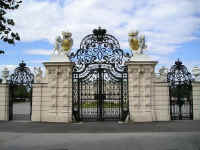Monday, 22 September. The bus left at 9:00 and took us on the Ringstrasse circuit that we hadn't been
able to do on Sunday. We went by the Opera House again, then, traveling clockwise, past the Hofburg,
Art History Museum, Natural History Museum, and the Palace of Justice. Then came the Parliament, not
only built in the classical Greek style, but with a huge statue of Athena out front. The elaborate New
Rathaus (1883) was equally impressive. HELLO as it passes Vienna. This canal is called the Danube River, while the original river bed through the city, We continues past the Votive Church, then followed the "original" Danube for several blocks. As a flood control measure, most of the Danube's waters are confined to a straight and relatively unattractive canal now only a small stream, is called the Danube Canal. The bus then turned back towards the old city center and dropped our group at Stephenplatz, site of Vienna's landmark St. Stephen's Cathedral. This is supposed to be a pedestrian zone, but deliveries are allowed for most of the morning hours. It seemed very hazardous with all the trucks and cars zooming through the mobs of tourists.
Janet pointed out the Giants' Door of the Cathedral, one of the few remaining parts of the earlier
Romanesque church that once stood here. The present church dates from the 14th and 15th centuries,
although it was restored after being badly damages during the Turkish siege of 1683, then again
after being almost completely destroyed by Allied bombs in 1945.
Janet then led us on a walking tour of the old city center. It was a charming area. We stopped at the Graben, a rather ugly monument to Vienna's survival of the plague. We had a nice view of the Hofburg's Michael's Gate down one of the narrow streets as we headed for the Café Central, one of Vienna's old coffee houses, located in the Palais Ferstel. After relaxing a while over coffee and cake. We resumed our walk. We came to Michael's Gate and stopped at the Roman ruins in the square. We past the Spanish Riding School and its museum, and came to Josefsplatz with its large equestrian statue of Kaiser Josef II in front of the National Library. Eventually we found our bus near the Albertina and got on board for our visit to the Belvedere Palace. There are actually two palaces, the Lower Belvedere (1714) and the Upper Belvedere (1721), but the upper one is the more magnificent. We remembered this beautiful palace from our 1961 visit. Built by Prince Eugen of Savoy on a gently rising hill, it still commands a striking view of old Vienna. We had time for a brief walk around the garden before the bus took us back to the hotel around noon. After a quick lunch, Jane and I took the subway to Stephenplatz for a more leisurely stroll around the old city. We spent some time looking over the interior of the church, then took the small elevator (at the pummerin) to the roof. There was a great view of the old city. Leaving St. Stephen's, we walked to the nearby Peterskirch (1708), renowned for its sumptuous baroque interior. It was being renovated, though, and much of it was hidden by construction curtains.
From there, we tried to walk through the Jewish Quarter, but I don't think we ever found it. Although we followed the directions in our guide book, we didn't see the synagogue or anything else distinctive to confirm it. Eventually we came to the Hoher Markt, the city's oldest square. It was built in the center of the original Roman garrison of Vindobona (the original name of Vienna). There are Roman ruins there, too. At one end of the square was the Anker Clock (1911), on an enclosed bridge connecting two buildings.
Continuing to our right, we came to a pleasant square (Lugeck) filled with tables from surrounding restaurants. At the end of the square was a beautiful white building. We still don't know what it was, though. We turned toward the Danube and proceeded to the Greek Orthodox Church and the Griechenbeisel (Greek Pub), an old inn (1447) claimed to be the oldest original building in Vienna.
Continuing on to the river, we caught the subway at Schwedenplatz, getting back to the hotel about 3:30. We just had time to get ready for the 5:15 bus departure for our ride to the Vienna Woods. We drove north, near the Danube, to the small town of Kahlenbergerdorf where we boarded the "tschu-tschu" train. This was a rubber-tired miniature train that traveled on the road. It took us up a narrow winding road to the top of the Kahlenberg, a small mountain, where we got off and walked a short distance to an overlook with a great view of Vienna and the Danube. The "tschu-tschu" then took us back down, and we boarded the bus again. It was a short ride to the Grinzing district where we were to have dinner at the Weinbotlich, a Heuriger (a casual vintners' tavern required to serve its own young, homegrown wine). We ate outside in the garden, enjoying the beautiful short-sleeve weather. Then it was back on the bus for the ride to our hotel. We arrived about 10:30. We were going to visit the Melk Abbey tomorrow, originally planning to go by train from the nearby Westbanhof. But we checked at the hotel desk to see if they could get us on a tour to the Abbey. We booked one that included a boat ride through the lovely Wachau Valley ending at Melk.
Copyright © 2000-2023 DarrellPeck.com All rights
reserved. | ||||||








